How to describe what happened last week? A Galapagos sea-voyage of 100 people (including Sylvia Earle, Leonardo DiCaprio, Edward Norton, Glenn Close, Elizabeth Banks, Steve Case, Ted Waitt, Bill Joy, Jackson Browne, Damien Rice, Chevy Chase, Jean-Michel Cousteau and 30 of the world’s leading marine scientists) turned into an epic event that may have significant impact on global efforts to save our oceans. It happened because the individuals and organizations on board chose to abandon the obstacles that often engulf nonprofit work, and engage in a process of emergent collaboration that I, for one, found truly thrilling.
Eight separate initiatives were kickstarted, aided by $15m in commitments from the individuals on board. These included:
- $1m to complete a package to protect the waters around Galapagos themselves
- $1.1m to launch a plan to protect the 1m-square-mile Sargasso Sea and commitments to raise a further $2.5m to see the plan through to success
- $350k to boost ocean exposure in schools
- $3.25m to commence a campaign to end fishing subsidies
- $10m to kickstart a new partnership to fund longer-term ocean projects
Not bad for four days’ work, especially as these commitments were not pre-planned. They emerged organically from the discussions on board in an untried process that worked better than anyone dared hope for.
In addition, we recorded more than 20 fabulous talks on ocean issues that are to be shared with the world on TED.com in the coming months, and which will end up being seen by literally millions of people.
So how did this come about? Here’s the story:
It began with “one wish to change the world.” That’s the gift given to winners of the TED Prize. Last year, the iconic ocean explorer Sylvia Earle was a recipient of the prize and in her blockbuster acceptance speech at TED, she declared her wish “to ignite public support for a global network of Marine Protected Areas, hope spots large enough … to restore the blue heart of the planet.” The speech inspired hundreds of offers of support, including a $1m pledge from investor/philanthropist Addison Fischer.
In the following months, the TED Prize team, headed by Amy Novogratz, worked intensively with the most promising offers, and plans were drawn up to embark on a new global awareness campaign. The agency Razorfish, working for us pro bono, came up with superb branding — active, exciting and ambitious. Mission Blue was born. But to mark the launch we decided to do something bold to kickstart interest. With Addison’s underwriting, and the confirmed availability of a perfect ship operated by Lindblad Expeditions, the Mission Blue Voyage to the Galapagos was born. The vision was referred to internally as “TED-at-sea.” By bringing together leading marine scientists with philanthropists and with thoughtful celebrities interested in this issue, we thought we could at a minimum:
- record memorable TED talks to boost understanding of — and passion for — the oceans
- give a transformative experience to people in a position to act
- raise money by charging passengers $20,000 to come
Three months before the scheduled departure date, things were not looking good. No famous names were signed up, and we had yet to sell our first ticket. In late January, in a conference call of interested parties, we had three options: postpone, cancel, or redouble our efforts. We decided to go for it. By the time TED2010 was held three weeks later, Chevy Chase and Jackson Browne had confirmed their interest, along with a few leading members of the TED community. And the speaker lineup was looking fantastic. We presented the trip as an epic voyage for those willing to engage in one of the biggest challenges to our future. By the end of TED, we knew our boat would be full.
But the question remained whether anything other than awareness-raising could be achieved.
A traditional solution to this problem might have been to decide on a goal — such as a petition or a specific marine protected area (MPA), or a funding request for the hosting foundation — and seek to rally everyone behind it. But in the past few years at TED, we’ve repeatedly been surprised and excited by the power of opening up involvement to a wider community. (Our TEDx program is the latest evidence of this, spawning 1,000 TED-like events in little more than a year.) So we decided to go for a different approach, and two weeks ahead of the trip, we invited all of our participants to consider influencing the outcome of the trip by becoming an “Idea champion.” This meant proposing an idea around which a group could form to plan specific action for the oceans.
We ended up with eight ambitious ideas, each with powerful strategic potential. They ranged from taking on creation of a specific new MPA, to launching a major education initiative for kids. On the first day of the trip, each champion presented their idea and sought recruits to join their team. Each idea won supporters, and groups ranging in size from 5-12 were formed.
The rules we gave to each group were simple but crucial to what was to follow:
- don’t come up with a plan that someone else will have to implement
- do come up with a plan that you and the other members of your group can implement with the resources you yourselves can raise
- do come up with a further plan that your group could implement if it had additional funding
- be audacious
(That final suggestion came from the tireless Richard Rockefeller, a catalytic presence on the trip.)
The quality of these discussions was boosted by the fact that each of the idea champions had extensive experience of oceans work, and often had an organization in place already working on their chosen issue. So, for example, the Galapagos protection plan was led by Peter Knights of WildAid, which has been working successfully in Galápagos for many years. Plus there was a clear sense from everyone that given the shocking threats to the ocean, this could not be just a pleasure trip. The celebs played a key role here. For example, on the very first evening, Ed Norton argued passionately to me that it was critical we came away with something concrete for Galápagos itself. And from the stage, Chevy Chase interrupted his own hilarious monologue with an eloquent plea for action.
Inspired by spectacular talks from Sylvia Earle and the other oceanographers on board, and by direct exposure to the nature wonderland of the Galápagos, the group conversations quickly got serious, and the issue of funding became one of the keys. How would we administer these different initiatives? I hosted a breakfast of leading philanthropists on board to see if there was appetite for a central fund for this purpose, and the usual problems quickly emerged. What foundation would receive the funds? Who would decide exactly how the projects were administered? How could individuals be associated with the projects they were most passionate about? How would we sidestep rivalry for funding from the different organizations involved? And wouldn’t this just become yet another organization in an already crowded space?
These issues have the ability to suck the oxygen out of the room, and for a while it looked like we wouldn’t find a way to do much that was concrete.
The key breakthrough was an act of generosity by Sylvia Earle. As mission leader, she could easily have insisted that all initiatives be organized through her new foundation http://mission-blue.org. Instead she agreed to a bold alternative. Let the support go directly to the organization leading each initiative. This massively multiplied the potential for action. By allowing the idea champions to work out their own plans with their groups, and then secure their support directly from individuals on board, real action plans snapped into place with astonishing speed. And it was done largely in a spirit of collaboration not competition. The participating organizations — including WildAid, Conservation International, Oceana, National Geographic, the Nature Conservancy, NRDC, IUCN — acted respectfully toward potential funders, and I overheard several celebrating each others’ successes. Hard to believe, but for some reason last week, that happened.
On the final day, as the eight groups reported back on what their members had committed to actually do, I looked around the room as jaws dropped and eyes moistened. The process took about an hour, and it was one of the most exhilarating, most hopeful hours of my life. Real change signed up for in real time. People dreaming big and then acting to make those dreams possible.
At the end of the hour, we gave everyone a blank sheet of paper and the chance to write down their own commitment for further action. Once again the words we received were awe-inspiring: promises to donate or raise, in aggregate, millions of dollars, offers of publicity, connection, creativity, advocacy and personal change.
In the next couple of weeks we will be outlining in more detail the actions and commitments that emerged. For now, I am still trying to make sense of it all. My instinct is that as the world gets more interconnected, we are on the verge of discovering new models for radical collaboration to take on the most challenging issues of our time. That is what we dreamed when the TED Prize was launched. Last week, it really seemed to be happening. Huge, heartfelt thanks to every one who helped make it so.
Photo credits, from top: Sylvia Earle: TED / James Duncan Davidson; Sylvia Earle at TED2009: TED / Asa Mathat; Endeavor: Sven-Olaf Lindblad; Jackson Browne, Laurie Coots, Chevy Chase: TED / James Duncan Davidson; eagle rays: Wolcott Henry; Ricardo Cisneros, applause, Glenn Close: TED / James Duncan Davidson.
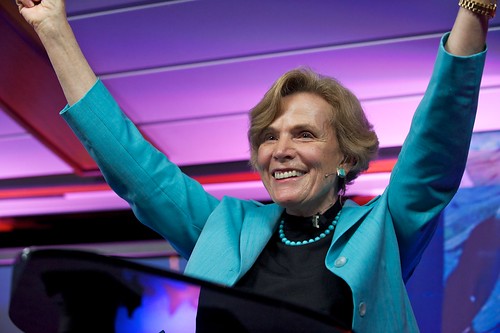

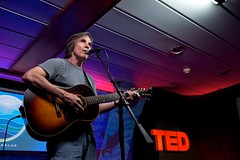
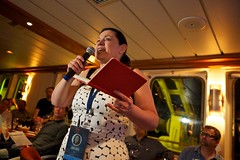


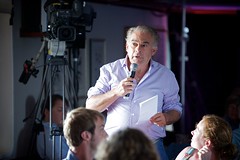
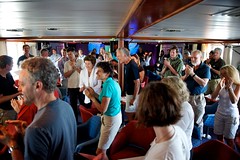

Comments (25)
Pingback: Mission Blue chronicles the life, loves and calling of ocean champion Sylvia Earle - Management Revolution
Pingback: Mission Blue chronicles the life, loves and calling of ocean champion Sylvia Earle | BizBox B2B Social Site
Pingback: Obama pledges support for massive new Pacific Ocean “hope spots,” echoing a TED Prize wish | BizBox B2B Social Site
Pingback: Learn more about ocean filmmaker Mike deGruy | Krantenkoppen Tech
Pingback: Sylvia Earle on Optimism and the Up and Down Sides of Fossil Fuels | "Global Possibilities"
Pingback: Sylvia Earle on Optimism and the Up and Down Sides of Fossil Fuels - NYTimes.com
Pingback: Day 114: Ocean Blind Tasting - Roz Savage, Ocean Rower
Pingback: TED Blog | Report from a Mission Blue hope spot: The Sargasso Sea